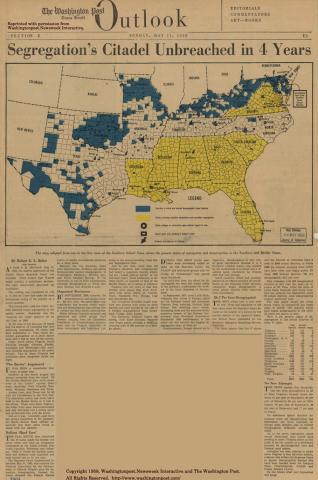
Description
The 1958 article from the Washington Observer observed the effects of the U.S. Supreme Court decision for Brown v. Board of Education. At the time of the May 1954 ruling, 17 states and Washington, D.C., had laws enforcing school segregation. By 1958, only seven states — Virginia, South Carolina, Georgia, Alabama, Florida, Mississippi and Louisiana — maintained public school segregation. The article highlights the immediate pushback within the states at the time of the ruling and how even four years later, a number of states continued to refuse to desegregate school districts.
Excerpt:
At 12:40 P.M. Monday, May 17, 1954 the marble courtroom of the United States Supreme Court was crowded. Chief Justice Earl Warren began reading a unanimous decision. His right black robed associates sat motionless.
The reading was completed at 1:10 p.m. and the Court had made the most unanimous ruling of the century on a social problem.
The Constitution, said the Court, forbids enforced racial segregation in the public schools. Discarded was the “separate but equal” doctrine set by the Court in 1896.
At the time of the decision, 17 states and the District of Columbia had laws enforcing segregation; 16 states had laws prohibiting it. Four states permitted, segregation on a local option basis and 11 had no laws on the subject.
Today, seven states---- Virginia, South Carolina, Georgia, Alabama, Florida, Louisiana and Mississippi--- still maintain complete segregation in the public schools. Two of these--- Virginia and Louisiana--- have integrated public colleges.
“The Border Acquiesced”
It has been a remarkable four years. In many ways Students of the South pegged the picture accurately from the outset. Of the 17 state Southern area, seven states were of the “border” variety: Delaware, Maryland, West Virginia, Kentucky, Missouri, Oklahoma and Texas.
Among these, only Texas cast its lot with the Confederacy in the Civil War. The plantation system had never taken hold in the Border States as it had in the others. There were fewer Negroes, the states were more industrial minded and only Kentucky had a strong social and sentimental link with the South.
And so it was. Generally--- and there are always exceptions in the paradoxical South--- Border State officials announced that their states would go along with the decision.
Transcript of "Segregation's Citadel Unbreached in 4 Years"
Source-Dependent Questions
- According to the U.S. Supreme Court in 1954, what foundational document forbids school segregation?
- In 1896, the Supreme Court used that same document to establish the practice of “separate but equal.” What might have caused that complete opposite change?
- According to the map, 17 states and Washington, D.C., had laws enforcing school segregation in 1954. By 1958, how many states still had school segregation laws?
Citation Information
Baker, Robert E. L., “Segregation’s Citadel Unbreached in 4 Years,” Washington Observer, 11 May 1958. Courtesy of Library of Congress